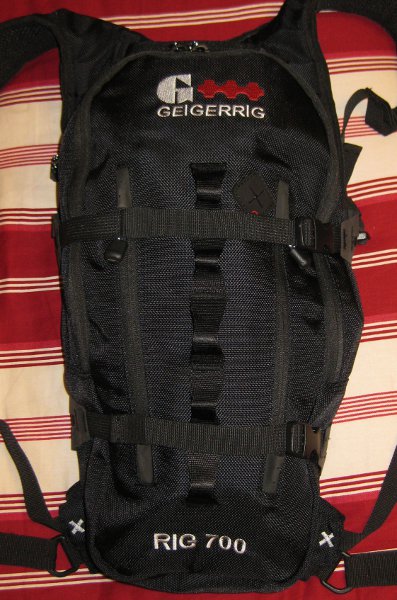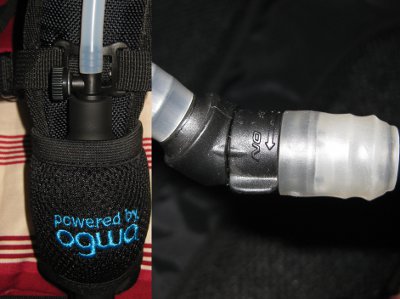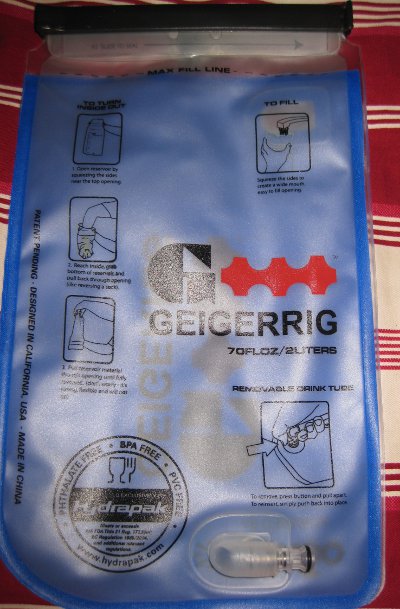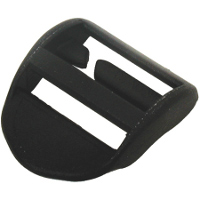GEIGERRIG Rig 700 Ballistic
Hydration Pack
GEIGERRIG's 700 cu in (11.5 L) pack with pressurized bladder.
Andrew Buskov
Initial
Report: September 19, 2011
Field Report: November 29, 2011
Long Term Report: January 29, 2012
 Tester Biographical
Information:
Tester Biographical
Information:
| Name: |
Andrew Buskov |
| Age: |
36 |
| Gender: |
Male |
| Height: |
5 ft 9 in (1.75 m) |
| Weight: |
215 lbs (98 kg) |
Torso:
|
22 in (56 cm)
|
Chest:
|
44 in (112 cm)
|
| Email: |
Rescue(at)Corridor9(dot)net |
| City, State Zip |
Madisonville, Kentucky
USA |
Backpacking
Background:
I’ve been backpacking for years now,
and finally have my ideal style. I’ve gotten my pack weight down to
between
20 to 25
lbs (11.3 - 13.6 kg) before water.
Day hiking is
nice, but
getting out over multiple nights is really what I enjoy. I like to take
my
time and enjoy the scenery as opposed to hiking hard. I also like being
comfortable and insist on an air mattress. I usually tent or hammock,
but stay in shelters when needed.
Product
Information:
| Item: |
Rig 700 Ballistic
|
| Manufacturer: |
GEIGERRIG
|
| Website |
http://www.geigerrig.com
|
| Year of Manufacture: |
2011
|
| MSRP: |
$130
|
| Listed Weight: |
1.20 kg (2 lbs 10 oz)
|
| Actual Weight: |
1.15 kg (2 lbs 8 oz)
|
 Product
Overview:
Product
Overview:
(From Manufacturer's documentation
& Website)
The GEIGERRIG Rig 700 Ballistic pack is a 700 cu in (11.5 L) heavy
duty ballistic nylon pack with a 70 oz (2 L) pressurized hydration
bladder.
The main compartment has 2 zippered entry points, one for contents, and
a smaller one for easy removal of the bladder. In addition to the main
compartment, there are four additional zippered compartments; two on
the outside of the pack and two compartments on the inside of the pack.
The two exterior compartments have zipper hoods to protect the contents
from rain. The right outside compartment also has a headphone hole to
allow the use of an iPod or other mp3 device. The interior pockets are
mesh and sewn to the outer main flap.
The hydration bladder itself is a completely new design from what I
usually use. Instead of a single main threaded fill hole, the entire
top of the bladder is folded over onto itself and secured with a
sliding piece of plastic. There are two connection ports on the bladder
that allow for tubing to be quickly connected or disconnected. One of
the connection ports is an exit point for the stored liquid while the
other is an entry point for pressurized air. Because the hydration bag
has a wall separating the two areas of the bladder, air will never
contaminate the liquid. Also included in this test (though optional) is
a filter ready drinking tube & GEIGERRIG in-line filter. This
allows
the user to fill the hydration bladder with unfiltered water as it will
pass through an activated coconut shell carbon filter before exiting
the drinking tube.
 Initial
Impressions:
Initial
Impressions:
The GEIGERRIG Rig 700 Ballistic pack arrived to my door in complete
condition with no damage. Included in my shipment was the Rig 700
Ballistic pack, an In-Line Filter, and a Filter Ready Tube. Looking at
the Rig 700 for the first time, it was apparent that this was not your
average hydration pack. Not only was the design of the hydration
bladder completely different from anything I've been exposed to before,
the pack itself appears to be designed for extreme use.
Immediately noticeable was the quality of the seams on the pack, as all
appeared in good condition and sewn very heavy duty. There are multiple
attachment points on both the straps and the face of the pack in
addition to the carry handle on top. The back side of the pack had five
very cushy areas with a cavity for air movement between the pack and
the users' back. At the bottom there appears to be a drain hole for the
bladder section, though I would hope that it was never used since the
bladder would need to bust.
The right shoulder strap holds the inflation bulb for the air side of
the hydration bag. By using this bulb, the user is able to pressurize
the bag so that the liquid 'sprays' out of the drinking tube rather
than the user having to suck the liquid out of the tube. As the liquid
is pressurized, and therefore sprayed from the drinking tube, it allows
the wearer to share a drink with another person without that person
contaminating the drinking tube with their own saliva. It also allows
the wearer to use the drinking tube to wash their hands, equipment, or
share with a dog; all without the need of physical contact with the
drinking tube end. The end of the drinking tube has what appears to be
a silicone sleeve that seals the end when not being bitten or pinched.
In addition, there is a twist valve that allows the flow of liquid to
be stopped completely. Both tubes thread through the pack with very
little effort.
The bladder itself has directions for use printed on it for quick
reference. These directions are easy to read & understand, and
provide information on size and cleaning techniques. The connection
points are not designed like the typical bladder either. Inside the
male coupling is a spring valve that closes when either the drinking
tube or the pressure tube is removed. This prevents water from leaking
out of the bladder even with all tubes removed.

This
appears to be a wonderful design as I am able to completely submerge
the bladder in a stream to fill it without having to remove the tubing
threaded throughout the pack. Because the in-line filter is on the
drinking tube side of the pack, I don't have to worry about
contaminated water as it is rated to remove 99.9% of Cryptosporidium
and Giardia
.
So far, my initial thoughts on the pack are quite positive. All of the
features appear to be well designed and construction seems to be very
durable. There are only two aspects of the pack that I have an issue
with. The first is the bottom inside zippered mesh area. Even with the
pack completely empty, it is a bit difficult to insert and remove items
from this pocket. If the main exterior zipper extended a bit further
toward the base of the pack, entry to the bottom mesh compartment would
be much easier. The second issue I have is with the chest strap. As I
rarely use a chest strap, I often remove them completely from my packs.
The hardware on this chest strap is sewn directly to the pack with no
way of removing it. I would like to see a split style clip similar to
the one on the left. This would allow the user to remove the entire
chest strap without damaging the buckles or webbing.
Field Report: November 29, 2011
Testing Locations:
Over the course of the past couple of months I have been able to get in
a number of hikes in the area ranging from five long day hikes, to a lot of
laps around the walking trail at the local land preserve. Because all
of these hikes were near to home, elevation was roughly 500 ft (150 m)
above sea level. The terrain was hilly, but not strenuous. Temperatures
during my outings were between 50 - 60 F (10 - 15 C) with little change
throughout the hike. Weather conditions were good each trip. There was
no precipitation of any kind, the wind was calm, and the sky was sunny.
Perfect weather conditions to get out in the woods.
Performance:
The GEIGERRIG Rig 700 Ballistic Hydration Pack has so far performed to
my expectations. The hydration system has functioned without problems
since the day I got it. It continues to remain easy to open, fill, and
close without any signs of weakening material or cracking of the
bladder or tubing. The only problem I have is that it continues to be
difficult to remove the bladder from the pack during filling. After the
test series is over, I may attach a quick-coupling device and just back
feed through the supply hose from my filter. This way I wouldn't have
to remove the bladder every time I wanted to refill at a stream. The
pressurization system works a lot better than I thought it would on the
trail; or maybe it's the fact that I didn't see myself using it as much
as I do. Many times I've cleaned my hands, spork, and washed out cuts
& scrapes with the water stream. The only drawback for me is more
of a mental one; as I'm used to a non-pressurized system I have found
that I tend to suck on the tube after the pressure in the bladder
falls. In short, I forget to pump up the bladder due to habit.
I've found that while the Rig 700 Ballistic Hydration Pack fits on my
back nice, it rides a bit high after walking for a few hours. This may
just be due to the pack becoming lighter due to my water consumption.
However, it is something that, while not uncomfortable, is still a bit
irritating if it continues over a long period of time. The zippers
remain functional despite a few times of over packing due to weather
conditions. At the time, my wife was using some of my lightweight rain
gear, this left me with the bulky stuff. This, coupled with the water
in the bladder, my personal effects, and a tarp made for a very stuffed
pack. This doesn't happen often as I prefer to travel light, and I
think it's time I got my lightweight gear back.
The material remains well intact, with no scratches or scuffs despite a
few battles with some brush on an unmaintained trail. I had to crawl
through some downed trees and through a patch of thorns on one hike and
while I had quite a few scratches on my arms, the pack did not suffer
any damage. I have not found the need to wash it yet as it really
hasn't been exposed to any dirt or mud. I have cleaned out the bladder
a few times though. Cleaning itself is relatively easy due to the
design, but as mentioned before getting all of the components out of
the pack is a bit of a pain. I wish there was an easier way to thread
the drinking tube through the shoulder strap. This would have to be one
of the aspects I dislike most about the Rig 700 Ballistic Hydration
Pack.
In all though, I must say that I am pleased with this pack so far. With
only one negative aspect, but many positive ones, I think this is an
excellent hydration pack. I will continue to use it as much as possible
and summarize my findings in the Long Term Report.
Long Term Report: January 29, 2012
Testing Locations:
During the final testing phase I was able to get an additional two
nights worth of testing and 4 day hikes. All of these hikes were in the
Western Kentucky area, with most being in the Land Between the Lakes
recreational area. All elevation was near the 500 ft (150 m) mark. Due
to the mild, yet still cold, winters I was only able to test this
equipment on warm weather days and nights with no precipitation.
Summary:
I've continued to be pleased with the GEIGERRIG Rig 700 Ballistic
Hydration pack. Additional use has shown that the pack really does stay
where I want it with little shifting in any direction. While I've been
able to use this on overnight trips, it was mainly used as a water
bladder and not nearly as much as a pack. I needed entirely too much
equipment to stay safe and warm to be able to use only the Rig 700
without an additional pack. I feel that the Rig 700 will see a lot more
use as a three season pack than it ever will during the winter months.
All material remains intact. No additional scratching or scuffs can be
found, and it still has not needed to be washed yet. The buckles
continue to remain intact and functional as do all zippers and pulls.
The bladder is still pliable with no cracking areas, and it is still
intact with all the continued use it has received. In short, all
materials used are in nearly the same condition as when the pack
arrived at my door.
My only complaint continues to be the hassle that is involved with
filling the pack, especially on the trail. Having to remove the bladder
completely from the pack to fill it is really a pain. While I had
discussed the option of adding a quick coupling to the hose tube so as
to back feed through the inline filter, I'm not so sure this would be
the best option. I would much rather see the manufacturer include a
quick coupling wye that would allow the bladder to be filled from the
dirty side of the system. That being said, the pack really is a pretty
ingenious design and one that serves its purpose.
I'd like to thank BackpackGearTest.org and GEIGERRIG for allowing me to
participate in testing the Rig 700 Ballistic Hydration pack.





 Product
Overview:
Product
Overview:
 Initial
Impressions:
Initial
Impressions:
 This
appears to be a wonderful design as I am able to completely submerge
the bladder in a stream to fill it without having to remove the tubing
threaded throughout the pack. Because the in-line filter is on the
drinking tube side of the pack, I don't have to worry about
contaminated water as it is rated to remove 99.9% of Cryptosporidium
and Giardia.
This
appears to be a wonderful design as I am able to completely submerge
the bladder in a stream to fill it without having to remove the tubing
threaded throughout the pack. Because the in-line filter is on the
drinking tube side of the pack, I don't have to worry about
contaminated water as it is rated to remove 99.9% of Cryptosporidium
and Giardia.